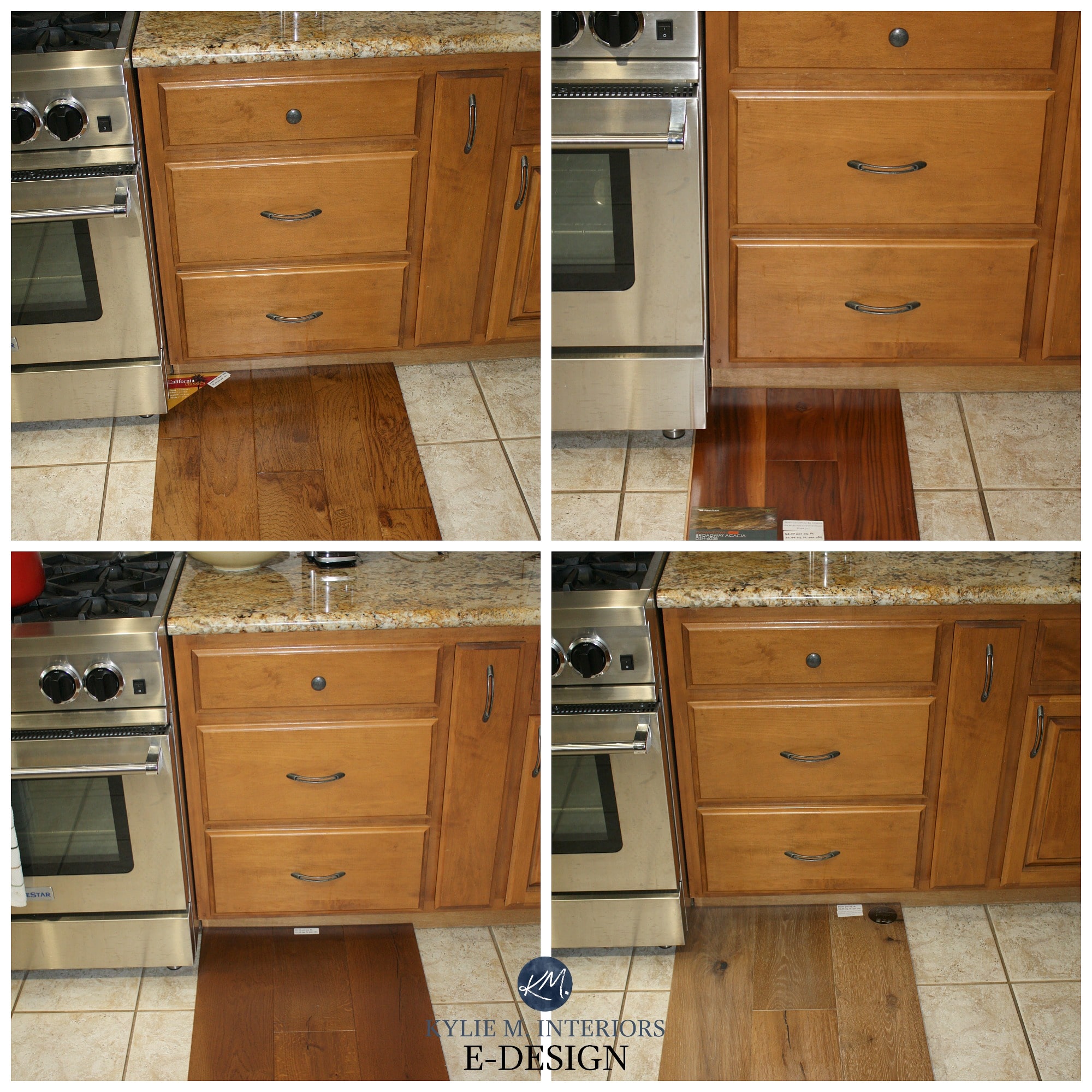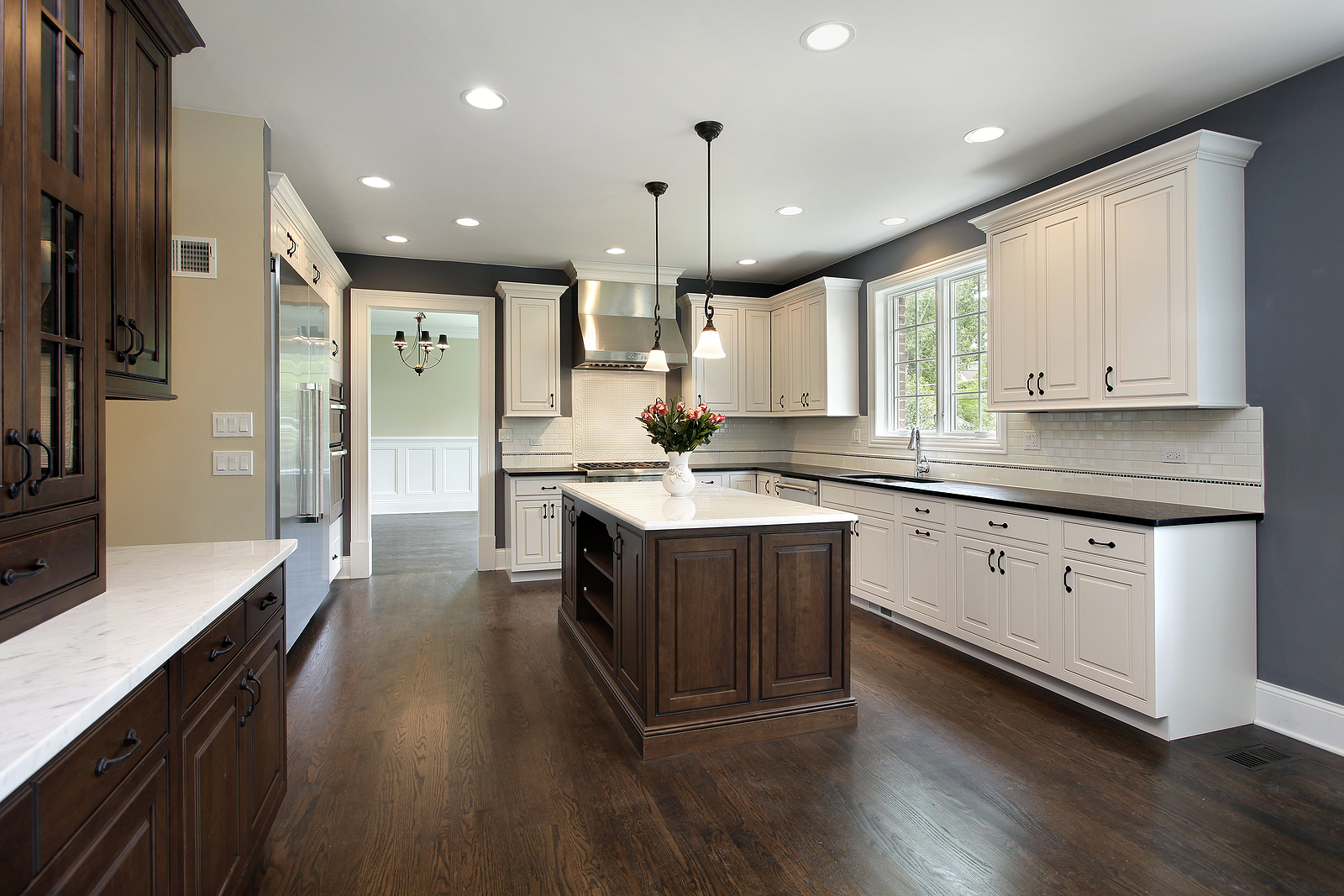Choosing Kitchen Cabinet and Flooring Styles: Coordinating Kitchen Cabinets And Flooring

The kitchen is the heart of the home, and its design plays a significant role in creating a welcoming and functional space. Choosing the right combination of kitchen cabinets and flooring is essential for achieving a cohesive and stylish look. This section explores popular kitchen cabinet styles, their compatibility with different flooring types, and design tips for achieving visual balance and flow.
Popular Kitchen Cabinet Styles and Flooring Compatibility
Cabinet styles significantly influence the overall aesthetic of a kitchen. Some popular styles include traditional, contemporary, farmhouse, and modern. Each style has unique characteristics and complements certain flooring types better than others.
- Traditional Cabinets: Characterized by ornate details, raised panels, and warm wood tones. These cabinets pair well with classic flooring options such as hardwood, tile, or stone.
- Contemporary Cabinets: Feature clean lines, sleek finishes, and minimal ornamentation. They work well with modern flooring like porcelain tile, engineered wood, or laminate with a contemporary pattern.
- Farmhouse Cabinets: Often feature distressed finishes, open shelving, and a rustic charm. They complement natural flooring options like reclaimed wood, cork, or stone with a rustic appearance.
- Modern Cabinets: Emphasize simplicity, functionality, and bold colors. They pair well with contemporary flooring options such as polished concrete, large-format tiles, or sleek vinyl planks.
Color Palette Considerations
Choosing a color palette for cabinets and flooring is crucial for achieving visual harmony and creating the desired ambiance.
- Contrasting Color Palettes: Offer a dramatic and eye-catching effect. For example, dark cabinets paired with light flooring create a bold statement.
- Complementary Color Palettes: Create a more balanced and harmonious look. For instance, warm wood cabinets can be paired with neutral-toned flooring, like beige or gray.
Design Tips for Visual Balance and Flow
Creating visual balance and flow between cabinets and flooring is essential for a cohesive kitchen design.
- Consider the Room’s Size: Darker cabinets and flooring can make a small kitchen feel even smaller, while lighter colors can create a sense of spaciousness.
- Think About Natural Light: Dark cabinets and flooring can absorb light, making a kitchen feel gloomy. Lighter colors reflect light, making the space feel brighter and more inviting.
- Use Texture to Add Depth: Combining different textures, such as smooth cabinets with textured flooring, can add visual interest and depth to the space.
Matching Cabinet and Flooring Materials

Choosing complementary cabinet and flooring materials is crucial for creating a cohesive and visually appealing kitchen. The right combination can enhance the overall aesthetic, while also considering practicality and durability.
Cabinet and Flooring Material Comparison
This section compares and contrasts different cabinet and flooring materials based on their durability, maintenance requirements, and aesthetic appeal. Understanding these factors can help you make informed decisions when choosing materials for your kitchen.
- Wood:
- Durability: Wood is a durable material that can last for decades with proper care. However, it can be susceptible to scratches, dents, and water damage.
- Maintenance: Wood requires regular cleaning and occasional refinishing to maintain its appearance. It’s important to use a sealant to protect against stains and water damage.
- Aesthetic Appeal: Wood offers a wide range of colors, grains, and finishes, allowing for a variety of styles. It can create a warm, traditional, or contemporary look, depending on the choice of wood and finish.
- Laminate:
- Durability: Laminate is a highly durable and scratch-resistant material that is also moisture-resistant. It’s a good choice for high-traffic areas.
- Maintenance: Laminate is easy to clean and maintain. It’s resistant to stains and scratches, making it a low-maintenance option.
- Aesthetic Appeal: Laminate offers a wide range of colors, patterns, and textures, mimicking the look of wood, stone, or other materials. It’s a versatile option for various styles.
- Tile:
- Durability: Tile is a durable and long-lasting material that is resistant to scratches, dents, and water damage. It’s a good choice for areas prone to spills and moisture.
- Maintenance: Tile requires regular cleaning to prevent grout build-up and maintain its appearance. It’s important to seal the grout to protect against stains and moisture.
- Aesthetic Appeal: Tile offers a wide range of colors, patterns, and textures, including ceramic, porcelain, and natural stone. It can create a classic, modern, or rustic look, depending on the choice of tile.
- Vinyl:
- Durability: Vinyl is a durable and water-resistant material that is also easy to clean. It’s a good choice for high-traffic areas and areas prone to spills.
- Maintenance: Vinyl is low-maintenance and easy to clean. It’s resistant to stains and scratches, making it a practical choice for kitchens.
- Aesthetic Appeal: Vinyl offers a wide range of colors, patterns, and textures, mimicking the look of wood, stone, or other materials. It’s a versatile option for various styles.
Matching Cabinet and Flooring Materials for a Cohesive Look
This section provides a practical example of a kitchen layout incorporating matching cabinet and flooring materials to achieve a cohesive look.
Example: A modern kitchen with white shaker cabinets and a light gray quartz countertop can be complemented by a light gray porcelain tile floor. This combination creates a clean and sophisticated look, with the light gray tones providing a sense of continuity and spaciousness.
Practical Considerations for Coordination

Beyond aesthetic harmony, coordinating kitchen cabinets and flooring involves practical considerations that ensure functionality and longevity. This section delves into crucial factors influencing the success of your kitchen design.
Kitchen Size and Layout
The size and layout of your kitchen significantly impact the choice of cabinets and flooring. In smaller kitchens, lighter colors and reflective surfaces can create an illusion of space. Conversely, larger kitchens allow for bolder choices and more intricate patterns.
For example, a small galley kitchen might benefit from light-colored cabinets and a patterned tile floor that runs the length of the room, while a spacious kitchen can accommodate dark cabinets and a large, geometric tile pattern.
Open-concept kitchens often incorporate flooring that seamlessly transitions from the kitchen to the adjacent living area, ensuring a cohesive flow.
Lighting
Lighting plays a crucial role in how colors appear in your kitchen. Natural light can make colors appear brighter and more vibrant, while artificial light can cast shadows and affect the perceived color of materials.
For example, warm-toned cabinets might appear more reddish under incandescent lighting, while cool-toned cabinets might appear bluer under fluorescent lighting.
Consider the type and intensity of lighting in your kitchen when selecting cabinet and flooring colors.
Personal Preferences
Ultimately, the most important factor in coordinating cabinets and flooring is your personal taste. Choose colors and styles that you enjoy and that reflect your lifestyle.
If you prefer a modern aesthetic, you might choose sleek, minimalist cabinets and a smooth, contemporary flooring. If you prefer a traditional style, you might choose ornate cabinets and a classic hardwood floor.
Don’t be afraid to experiment and find what works best for you.
Budget and Functionality, Coordinating kitchen cabinets and flooring
The budget for your kitchen renovation will inevitably influence your choices. Some materials are more expensive than others, and the cost of installation can vary depending on the complexity of the project.
For example, custom cabinets are typically more expensive than stock cabinets, and hardwood flooring is generally more expensive than laminate flooring.
Consider the functionality of your kitchen and how it will be used. If you have young children, you might choose durable and easy-to-clean flooring. If you entertain frequently, you might choose a flooring material that is scratch-resistant and easy to maintain.
Ease of Cleaning
The ease of cleaning your kitchen cabinets and flooring is an essential consideration. Some materials are more prone to stains and scratches than others.
For example, light-colored cabinets can show dirt more easily than dark-colored cabinets, and hardwood floors can be more susceptible to scratches than tile floors.
Choose materials that are easy to clean and maintain, especially in high-traffic areas.
Just as coordinating kitchen cabinets and flooring creates a cohesive visual flow, the right lighting in a bedroom music studio can significantly impact the mood and functionality of the space. When setting up a music studio, carefully consider the type and placement of lights to ensure optimal sound quality and visual comfort.
For a comprehensive guide on selecting the perfect lighting for your bedroom music studio, bedroom music studio lighting is a valuable resource. Just like a well-designed kitchen, a properly lit music studio enhances the overall experience, making it both enjoyable and productive.
Coordinating kitchen cabinets and flooring is a crucial aspect of creating a cohesive and visually appealing space. While many factors contribute to this harmony, the color and finish of your cabinets play a significant role. To ensure your cabinets complement your flooring choices, consider using a high-quality paint that delivers both durability and aesthetic appeal.
For a comprehensive guide on the best brand of paint for kitchen cabinets in 2016 , explore the available options and choose a brand that aligns with your desired finish and performance. Ultimately, the right paint choice can elevate your kitchen’s overall design and create a seamless flow between cabinets and flooring.
